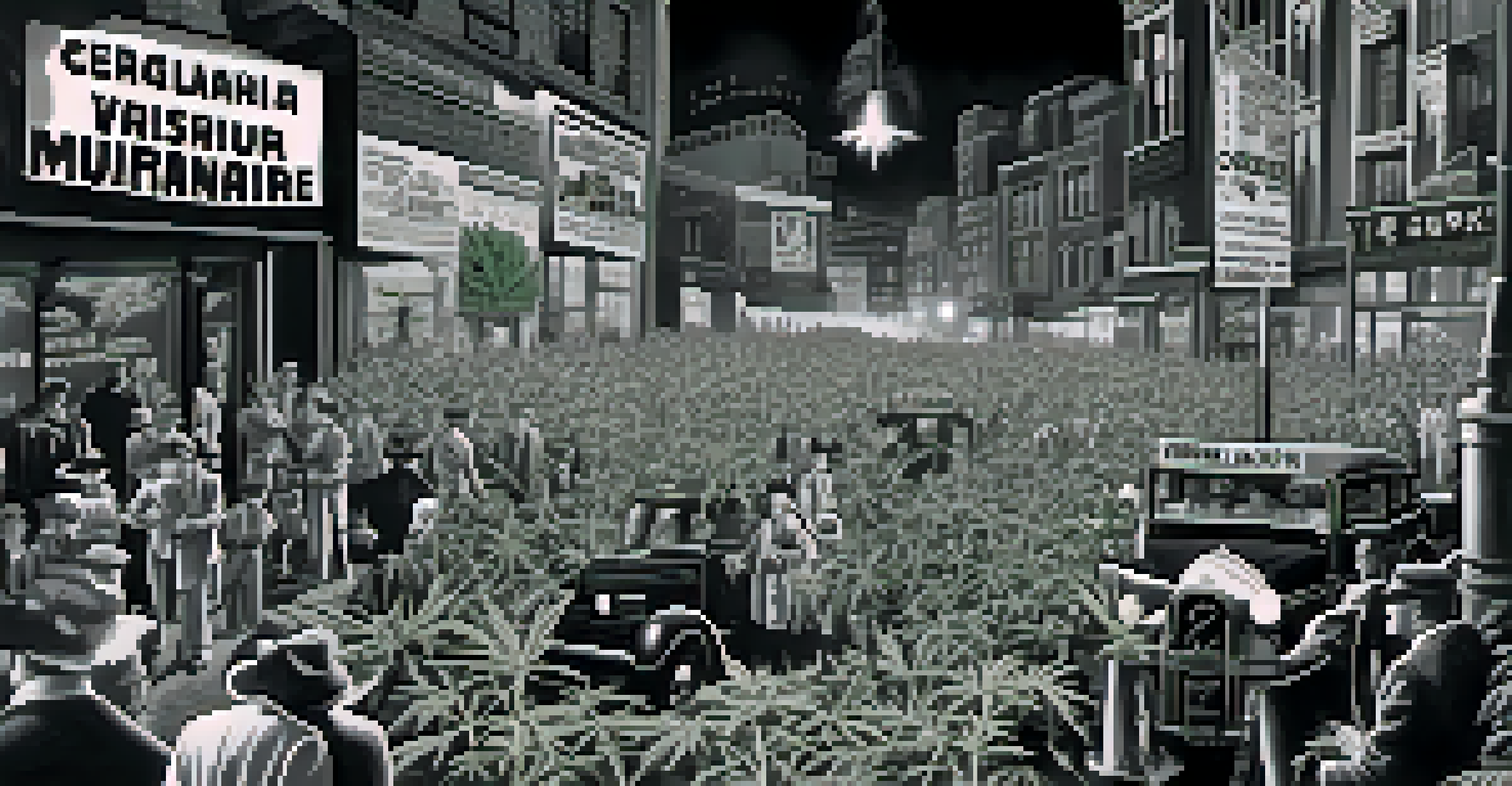The Origins of Marijuana Legislation in Early 20th Century America

The Early Use of Cannabis in America
Marijuana, or cannabis, has a long history in America, dating back to the colonial era. Early settlers utilized hemp for various purposes, including rope, clothing, and other textiles. The plant was not viewed negatively; in fact, it was often encouraged for its economic benefits.
The greatest danger of marijuana is that it leads to the use of harder drugs.
By the 19th century, cannabis extracts were common in medicines and tonics, sought after for their therapeutic properties. Many Americans were unaware of the potential controversies surrounding the plant. This positive perception would soon begin to shift as societal attitudes evolved.
As we moved into the 20th century, however, the landscape began to change, influenced by various cultural and political factors. The perception of marijuana would soon become entwined with issues of race and class, setting the stage for future legislation.
The Influence of the Mexican Revolution
The Mexican Revolution in the early 1900s brought a wave of Mexican immigrants to the United States, many of whom brought with them the traditional use of marijuana. This cultural exchange introduced new attitudes towards cannabis, but it also sparked fear among some American communities.

The association of marijuana with Mexican immigrants fed into existing racial stereotypes, making the plant a target of prejudice. As fears of immigration and cultural change grew, so did the negative perceptions of marijuana. This sentiment laid the groundwork for future legislative actions against the drug.
Colonial Cannabis's Positive Start
Early American settlers valued cannabis for its practical uses, viewing it positively for its economic benefits.
Thus, the combination of cultural integration and racial bias began to shape a narrative around marijuana that would influence public opinion and policy. It was a turning point that marked the beginning of an era characterized by increasing regulation and stigma.
The Formation of Anti-Marijuana Sentiment
In the 1930s, anti-marijuana sentiment gained traction, largely fueled by propaganda campaigns that painted the drug as a dangerous menace. One notable figure during this time was Harry Anslinger, the first commissioner of the Federal Bureau of Narcotics, who played a pivotal role in shaping public perception.
Marijuana is a drug that creates a sense of euphoria, but it is also a drug that opens the door to other drugs.
Anslinger's campaigns included sensationalist claims linking marijuana use to violent crime and moral decay, which resonated with a fearful society. His efforts contributed to a growing public outcry for stricter controls and an outright ban on the substance.
This fear-driven narrative not only swayed public opinion but also influenced lawmakers, leading to the first significant anti-marijuana legislation. The groundwork for federal prohibition was being laid, marking a dramatic shift in the legal landscape.
The Marihuana Tax Act of 1937
The culmination of these efforts was the Marihuana Tax Act of 1937, which effectively criminalized marijuana by imposing strict regulations and heavy taxes on its sale and possession. This legislation marked the first federal attempt to control cannabis, and it was met with little resistance at the time.
The Act required anyone dealing in marijuana to pay a tax and register, creating a bureaucratic maze that made legal use nearly impossible. It also reflected the prevailing attitudes of the era, which were steeped in racial and cultural biases.
Racial Bias Shifts Marijuana Perception
The influx of Mexican immigrants and racial stereotypes in the early 1900s contributed to a growing negative perception of marijuana.
As a result, the Marihuana Tax Act laid the foundation for future drug legislation, cementing marijuana’s status as a controlled substance. This would have lasting effects on society and the legal framework surrounding cannabis.
The Role of Media and Public Perception
Media portrayal played a significant role in shaping public perception of marijuana during this period. Films like 'Reefer Madness' were produced to depict marijuana users as dangerous and deranged, further entrenching negative stereotypes.
These sensationalized narratives captured the public's imagination and fueled fears around marijuana consumption. As a result, society began to view cannabis not as a harmless plant but as a gateway to chaos and criminality.
This shift in perception was crucial in garnering support for the increasingly punitive measures against marijuana. The influence of media cannot be understated in how it shaped the conversation around drug use.
The Impact of World War II and Beyond
During World War II, the U.S. government encouraged hemp production for wartime materials, temporarily easing the stigma around cannabis. However, post-war America saw a return to strict anti-drug sentiments, partly as society grappled with returning veterans and changing social norms.
As the 1950s approached, anti-marijuana propaganda was revived, leading to more stringent laws and harsher penalties for possession and use. The public discourse around marijuana continued to be dominated by fear and misinformation.
Anti-Marijuana Laws Emerge in 1937
The Marihuana Tax Act of 1937 marked a significant legal shift, imposing heavy regulations that criminalized marijuana and reflected societal fears.
This cycle of regulation and backlash would set the stage for the counterculture movement of the 1960s, where marijuana would be embraced by a new generation. The contrasting views on cannabis were becoming increasingly polarized, highlighting the complexity of marijuana legislation.
Legacy of Early 20th Century Legislation
The early 20th-century legislation surrounding marijuana laid the groundwork for decades of stigma and legal battles. The Marihuana Tax Act and subsequent laws created a legacy that affected millions, shaping societal attitudes toward drug use.
As the conversation around cannabis has evolved in recent years, understanding these historical roots is crucial. The early legislation was not merely about a plant; it reflected deeper societal issues related to race, culture, and fear.

Today, as many states begin to legalize marijuana for medicinal and recreational use, the shadows of past legislation remain. The journey toward reform continues, highlighting the importance of learning from history to pave the way for a more equitable future.